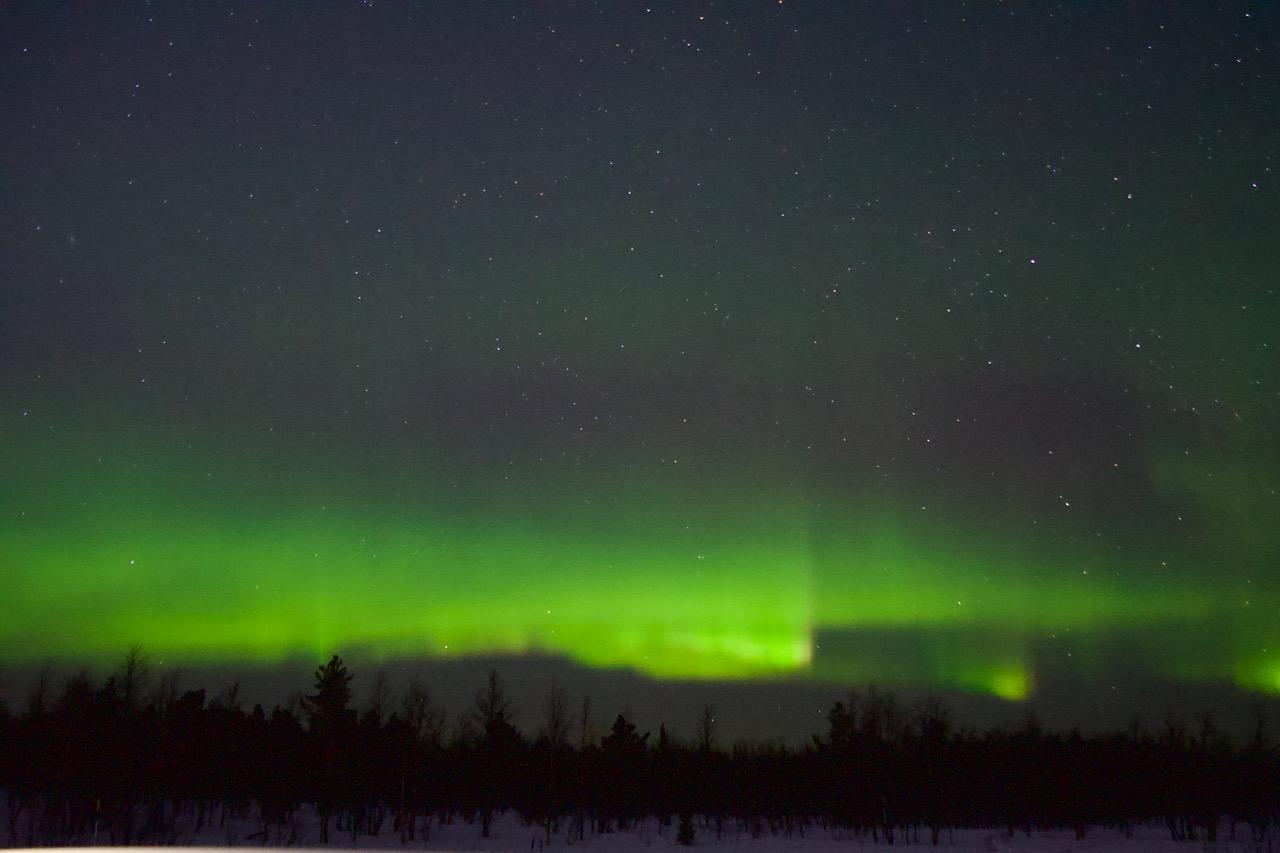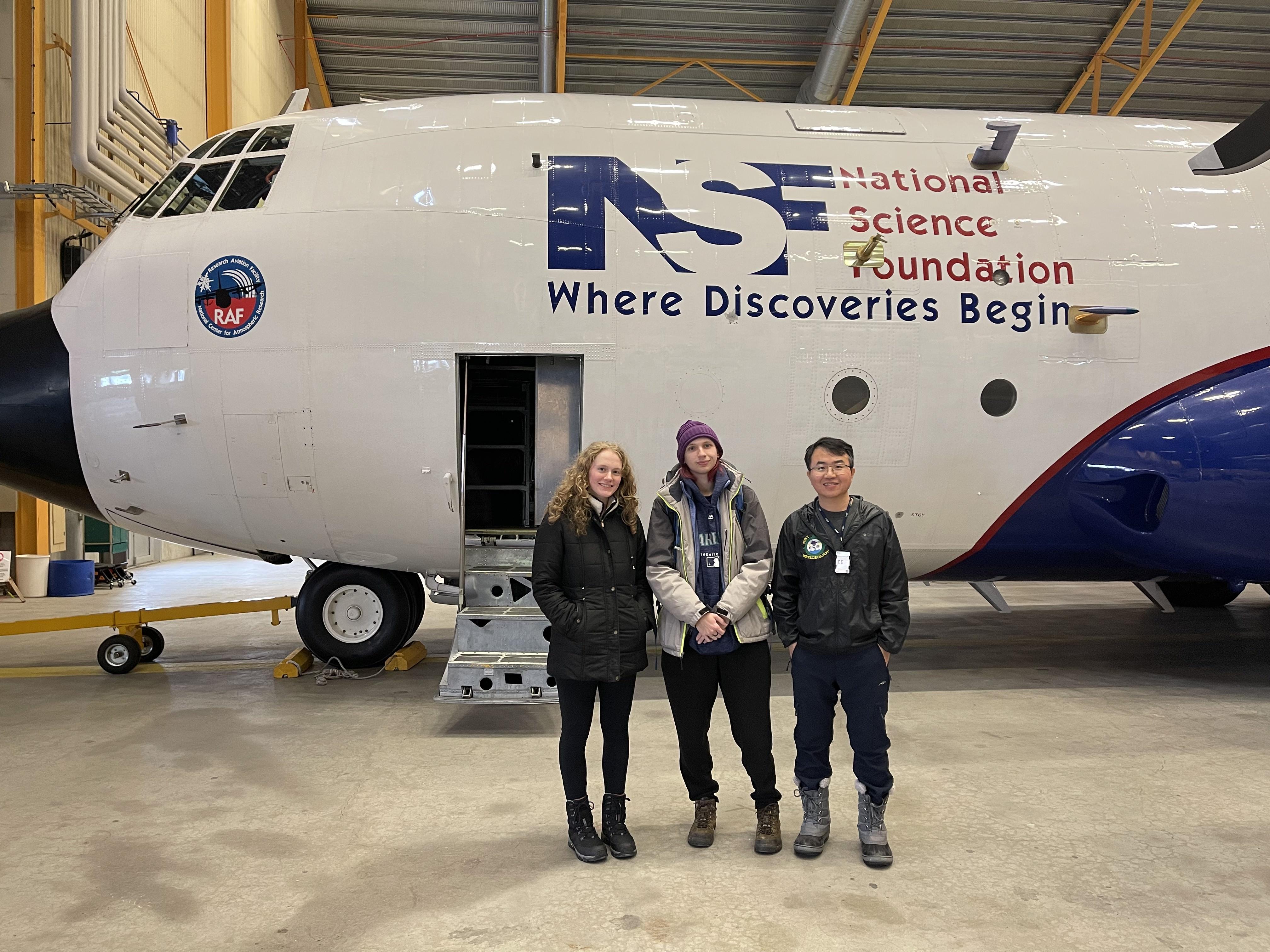Oswego students Sarah Gryskewicz and Bee Lamsma, and meteorology professor Yonggang Wang stand in front of the National Center for Atmospheric Research (NCAR) research aircraft.
Four SUNY Oswego students — Ezekiel Caldon, Sarah Gryskewicz, Bee Lamsma and Josephine Ragland — recently returned from a research project during the spring 2024 semester studying cold air outbreaks in the subarctic region.
The field campaign, referred to as the CAESAR project for short, was hosted by Oswego meteorology professor Yonggang Wang, who received a $234,022 grant from the National Science Foundation (NSF) in 2023 to support the research.
On the trip, students were able to conduct research on a state-of-the-art National Center for Atmospheric Research (NCAR) C-130 aircraft, using dropsonde measurements to document convective clouds during cold-air outbreaks. The clouds can produce heavy snowfall, occasionally generating intense “polar lows” that affect the overall climate of the Arctic.
“We’re used to just typical radiosondes which are basically just dropsonde’s opposite because a dropsonde descends and a radiosonde ascends,” said Gryskewicz, a sophomore meteorology major. “So I was really interested in that instrumentation and how different it was compared to what we’re used to now.”
A typical day on the CAESAR project trip included a forecast briefing, collecting research from the aircraft, debriefing and discussing the data collected and some downtime to see the sights of Sweden. Students were able to work with graduate students, professors and other researchers from eight U.S. universities; Stockholm University, Sweden; University of Oslo, Norway; and the U.S. Naval Research Laboratory.
“Just being with so many different branches of meteorology, because we were studying aerosols, climate, cloud microphysics and there were so many specialists in those fields so being able to see how they worked was very cool,” said Lamsma, also a sophomore studying meteorology.
In their downtime, students were able to tour a hotel made entirely of ice and snow and see the northern lights, which Lamsma said was “Phenomenal. The trip was so much fun. While science was the main objective we got to do so many cool things.”

Photo provided by Bee Lamsma.

Photo provided by Ezekiel Caldon.
Significance of the research
Due to the unpredictable nature of cold air outbreaks in the Arctic region, Wang and his students said that they can be difficult to model, similar to the challenges of forecasting lake-effect snow patterns in Oswego.
“Cold air outbreaks are of course very similar to lake effect storms, but it was very interesting to hear about what makes these cold air outbreaks that we don’t necessarily talk much about in the classroom,” said Gryskewicz. “In particular, the aerosol and microphysical content of these clouds because I haven’t had much experience with them.”
Caldon explained that there is very little data or understanding of these microphysical processes, which is why it’s so important to research.
“[It’s] important because the Arctic is more sensitive to the effects of climate change, and we’re using climate models to study how fast arctic ice is melting,” said Caldon. “A big element to [that research] is clouds… So if we can model these types of clouds better we can actually do a better job of modeling Arctic ice and the climate in the Arctic.”
Gryskewicz said she was grateful to learn from scientists who have built a career in a field she would like to work in one day.
“Being on a research aircraft is not something you get to do every day and is very rare as an undergrad, so I really got to be exposed to the field, working with a lot of different people, a lot of different perspectives and how people came to be in their career,” Gryskewicz explained. “A lot of people have different career paths and take a lot of different avenues to get where they are now.”

Photo provided by Sarah Gryskewicz.
Lamsma also spoke about the valuable connections they made on this trip, including one offer to be a reference for job opportunities.
“There was one scientist I worked with closely and at the end was like ‘it’s been a pleasure working with you. Your forecasts were amazing. If you ever need a letter of recommendation let me know,'” said Lamsma.
Caldon said it was an honor to work alongside established scientists and graduate students.
“One of the experiences I was able to have was contributing to a forecast discussion. I added to slides that other professors and grad students from other universities were on so it was really cool to contribute to that discussion,” said Caldon. “Meeting potential grad advisors, and also learning more about how these research trips function is really interesting to see how these scientists interact and plan what they’re going to measure.”
The students all expressed their gratitude to Wang for making this opportunity possible. Lamsma, in particular, spoke about their appreciation for his teaching style.
“We had to do something for Quest and during [the trip] I was like, ‘It’s really annoying that our satellite communications system isn’t working.’ So I proposed to him that I wanted to try and figure it out and see what variables corresponded to it, and he was like ‘Go for it!’” said Lamsma. “[He] gave me a couple of resources and people to contact and let me go. It was nice being able to be in control of my own research and I’m very thankful to him for giving me this opportunity.”
Gryskewicz also expressed her gratitude not only for Wang and this experience but for the Oswego meteorology department as a whole.
“[I’m] very grateful. I’ve had experiences in the past from the department, but I’ve never gotten to travel internationally so this is my first field campaign that’s very much bigger than myself and with many different people from many different institutions,” said Gryskewicz. “I’ve never worked with this many people from different places before. So being an undergrad, it was very inspiring and eye-opening and it’s something I’ll never forget.”




